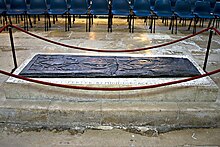Remigius de Fécamp
| Remigius de Fécamp | |
|---|---|
| Bishop of Dorchester Bishop of Lincoln |
|

Remigius' tomb in Lincoln Cathedral
|
|
| Appointed | 1067 |
| Term ended | 7 May 1092 |
| Predecessor | Wulfinus |
| Successor | Robert Bloet |
| Other posts | Almoner of Fécamp Abbey |
| Orders | |
| Consecration |
c. 1067 by Stigand, Archbishop of Canterbury |
| Personal details | |
| Died | 7 May 1092 |
| Denomination | Catholic |
Remigius de Fécamp (sometimes Remigius; died 7 May 1092) was a Benedictine monk who was a supporter of William the Conqueror.
Remigius' date of birth is unknown, although he was probably born sometime during the 1030s, as canon law in the 11th century required a candidate for a bishopric to be at least 30 years of age. Likely, he was named for Saint Remigius, and the name was an unusual one for Normandy in that period. It may imply that he was always intended for a career in the church, and may have been a child oblate. He was a monk at Fécamp Abbey, holding the office of almoner, although the information that he held that office only dates from the Ship List, a listing of ships used by William the Conqueror in the initial invasion of England in 1066. This list only exists in a mid-12th-century manuscript, but is likely a copy of an original list dating to right after 1066.
Remigius was related to William in some unknown manner. He was also related to Walter D'Aincourt, who was also related to King William II of England. Both of these relationships are documented on a lead plate said by the antiquarian William Dugdale to have been found in the grave of D'Aincourt in Lincoln Cathedral. The historian David Bates argues that the relationship to the Aincourt family is likely, based on fact that the family held lands near Fécamp. Bates is less inclined to believe in any relationship to either William I or William II, but feels it isn't possible to rule it out either, due to the complex nature of the early history of the Norman ducal family. Bates speculates that whatever relationship may have existed between Remigius and King William may have been from Remigius' possible descent from an earlier ducal concubine.
The medieval writer Henry of Huntingdon states that Remigius was a participant in the Norman Conquest of England, and was at the Battle of Hastings in 1066. The Ship List states that Remigius contributed one ship and 20 knights to the invasion force used by William the Conqueror in addition to his presence at Hastings. However, as mentioned earlier, this list only survives from a 12th-century copy which originates from Battle Abbey, the monastery founded by King William to commemorate his victory at Hastings. Battle was known to have manufactured documentary evidence to support its claims to lands as well as to have embellished the historical record to enhance its reputation. The Ship List's authenticity has been challenged, but the most recent editor of the manuscript feels that it is a copy of an earlier 11th-century listing, and thus is substantially accurate.
...
Wikipedia
